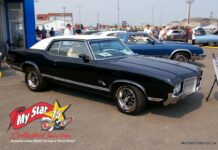There is little doubt that today’s world can get pretty complicated at times, given our easy access to the information highways that can occasionally lead us down a perilous path of misinformation.
The net result is a cyber landslide of information that may or may not be true, depending upon the source.
Jim Sutherland
Most people yearn for the good old days when things were more cut and dried in their lives. I tend to agree with this basic conclusion, but there are exceptions to the rule, including the vintage vehicle hobby, because less information did not necessarily mean accurate information back in the day.

I used to rely heavily on paper print publications like daily newspaper want ads, weekly buy/sell periodicals, and monthly automotive magazines dedicated to the old car hobby in search of the vintage rides of my dreams. The sellers offered a very basic view of the old car or truck, mostly in a written description with a contact phone number in the ad. Sometimes the magazines would include a grainy picture that was usually an automotive version of the famous Loch Ness monster photo in terms of clarity.

Therefore, potential buyers had to rely heavily upon the written information followed by a phone conversation with the sellers. It was an uncomplicated process, but it relied too heavily upon the honesty and/or accuracy of the seller on the other end of the phone.

A prospective buyer had to decide whether to take a trip to see the vintage vehicle in person. The decision was easy if the seller lived in the area, but the process got more complicated by the mile if the vehicle was located outside of the buyer’s community.

I speak from experience on this matter because I took too many road trips to see vehicles that were not as advertised in the paper publications. One vehicle ad comes to mind because the car was the wrong year, a fact that did not seem to matter to its owner. Plus, it was several hours away from my home, so I will never get back my time from the hunt for my concept of an ideal old car at that point in my life.

The ideal car was advertised in a paper buy/sell publication as a 1967 Dodge Coronet 500 two-door hardtop. I was a big fan of the 1967 Coronet 500 because my brother-in-law purchased one brand-new and I really like the look of the ’67 edition.
The 1966 Dodge Coronet 500 was very similar to the ’67 version, but it had some important cosmetic differences on the front and back end that were not as appealing to me-plus my brother-in-law never owned a 1966 Coronet, so it was 1967 or nothing for me.

The trip took me several hours south of my home through a major city and into a rural area south of the big city. The guy opened the garage door, and I immediately spotted the back end of a 1966 Dodge Coronet 500 instead of the advertised 1967 version.

I was not happy when I saw the car and told the guy I would not have driven that many miles on the road for a ’66 Coronet. His personality bordered heavily on a nether region in the human anatomy, so he responded with “What’s the difference?”-not an acceptable answer for me at the time-or even now for that matter. We parted ways on very bad terms, but he did adjust his ad to a 1966 Coronet the next week. Lesson learned for both of us.

There were some great car deals available back in the dark ages before the dawn of digital photo ads, but car guys really had to trust the information provided by the seller. Come to think of it, car guys also really have to trust the information (and photos) provided by a 21st century seller even if he does have pics because they may be photoshopped-or worse–he may not even own the car.

That sad new age car guy adventure will be the inspiration for a future article here at MyStarCollectorCar.
Jim Sutherland
BY: Jim Sutherland
Jim Sutherland is a veteran automotive writer whose work has been published by many major print and online publications. The list includes Calgary Herald, The Truth About Cars, Red Deer Advocate, RPM Magazine, Edmonton Journal, Montreal Gazette, Windsor Star, Vancouver Province, and Post Media Wheels Section.
- CLICK HERE to Sign Up for the Newsletter
- CLICK HERE to Like us on Facebook
- CLICK HERE to Follow us on Twitter
- CLICK HERE to Follow us on Pinterest

























































